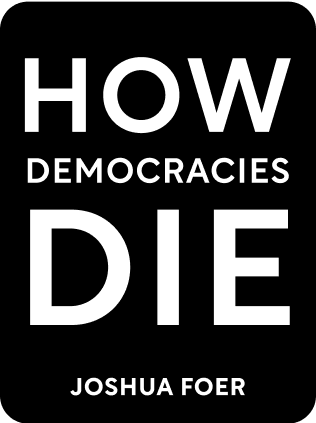

This article is an excerpt from the Shortform book guide to "How Democracies Die" by Steven Levitsky and Daniel Ziblatt. Shortform has the world's best summaries and analyses of books you should be reading.
Like this article? Sign up for a free trial here .
What is asymmetric polarization? Why are the political parties becoming increasingly polarized in America?
Asymmetric polarization is where one party becomes more extreme than the other in its political stance. In their book How Democracies Die, Levitsky and Ziblatt argue that growing asymmetric polarization in American politics is due to two factors: 1) the power of conservative interest groups, and 2) the cultural homogeneity of the party’s base.
We’ll discuss both of these factors below.
Identity Politics and Asymmetric Polarization
In How Democracies Die, Levitsky and Ziblatt argue that political polarization is about far more than traditional disagreements over political issues or liberal versus conservative ideology. Polarization reflects deeper and more fundamental divisions in society, like race, religion, sexuality, and culture. These are not new forms of division by any means, but Levitsky and Ziblatt contend that they’ve never before been so neatly folded into the structure of the two-party system. Partisan affiliation increasingly encompasses these other, more emotionally resonant forms of identity, not merely political belief—which makes compromise or accommodation far more difficult.
The Republican Party, they argue, has become overwhelmingly the party of exurban and rural white Christians. The Democrats, meanwhile, are increasingly the party of secular, urban non-whites. Thus, one’s political identity is about far more than just beliefs about public taxing and spending policy—it is about one’s core identity and set of values. This makes the parties more and more unrecognizable to one another—and less and less willing to extend mutual respect and institutional forbearance to one another.
Although these homogenizing trends have played out in the coalitions of both major parties, the authors argue that they have been far sharper in the Republican Party. They do not deny that Democrats have drifted leftward on economic and social issues; but they contend that the GOP has swung far more to the right. Beyond the influence of right-wing media, they attribute this asymmetric polarization to two factors:
- The power of conservative interest groups
- The cultural homogeneity of the party’s base
| The Democratic Shift to the Left Although Levitsky and Ziblatt label the Republicans as the primary driver of asymmetric polarization, it’s worth exploring how much the Democrats have also moved away from the political center, especially in recent years. In the 2020 Democratic primaries, viable candidates like Elizabeth Warren and Bernie Sanders proposed policies that would have been considered far to the left of the median voter only a few election cycles before, including: reparations for the descendants of enslaved people, universal childcare, a wealth tax, and forcing corporations to reserve 40% of the seats on the boards of directors for workers. Self-identified liberals comprise a far larger share of the Democratic base than they did during the 1990s. In 1994, self-identified moderates made up half the party, while liberals made up only a quarter. In 2020, liberals represented half the party, while moderates represented only a third. And this move to the left may be influencing how the broader American electorate views the party. A 2019 Quinnipiac poll showed that nearly half the country thinks the Democratic Party has moved too far to the left. |
Conservative Interest Groups
Ziblatt and Levitsky argue that Republican politics are also shaped by a network of powerful and well-funded conservative interest groups that put pressure on GOP officeholders to hold the line on ideology. One example they cite is the group Americans for Tax Reform, headed by longtime activist Grover Norquist.
Norquist’s group has successfully pressured nearly every Republican member of Congress to sign a “no tax” pledge, committing them to oppose any form of federal revenue increase. According to the authors, these pressure groups help to shape party orthodoxy, enforce ideological uniformity, and discourage norms of mutual toleration and institutional forbearance within Congress.
| The “No Tax” Pledge and Conservative Goals Some commentators have argued that pledges like Grover Norquist’s “no new taxes” creed not only make compromise and functional democratic government impossible, but also undermine the conservative ideological goals they’re supposed to help. Although the pledge has indeed become party orthodoxy (more than 80% of Republicans in the 2021-2023 congressional session have signed it) it has largely robbed them of their ability to negotiate with Democrats, placing them in a maximalist, “all or nothing” position that makes it extremely difficult for them to vote for legislation that would help them advance the cause of conservatism. For example, in August 2011, all eight Republican presidential candidates declared on a debate stage that they would not accept a deficit-reduction package with even a 10:1 ratio of spending cuts to tax increases. In other words, they were forced to sacrifice long-desired spending cuts and sweeping deficit reduction (both major goals of the conservative movement) because the pledge bound them to accept no revenue increases whatsoever. |
Cultural Homogeneity
Finally, Levitsky and Ziblatt highlight the racial and cultural homogeneity of Republican voters themselves. They argue that the GOP has become a near-homogenous party of white Christian voters. For most of the country’s history, white Christians comprised the majority of the electorate and sat atop the social and economic order. But in a few short decades, this dominant position has collapsed, and white Christians now comprise a minority of the electorate (although they are still the plurality).
The authors theorize that this has given rise to a siege mentality within this community. They increasingly feel embattled by the profound social and cultural changes that have swept the country. Levitsky and Ziblatt cite surveys showing that white Christians believe the country is slipping away from them and that they see themselves as the “real Americans” (in other words, native-born, English-speaking white, Christian). Thus, conspiracy theories like birtherism are tapping into something very potent for a lot of white voters—a sense of loss for a country they no longer recognize.
| The Twilight of White Christianity The Republican party has indeed become highly dependent upon white Christian voters, a group that now comprises just 42% of the U.S. population as a whole. According to Pew Research, 79% of registered Republicans were self-identified Christians on the eve of the 2020 presidential election, compared to 52% for Democrats. Furthermore, the same research found that 81% of registered Republican-leaning voters were non-Hispanic whites, compared to 59% for Democratic-leaning voters. However, Levitsky and Ziblatt’s portrayal of this group as being in an inexorable demographic decline toward political irrelevancy may be somewhat overstated. Pew’s research shows that white Christian voters are highly overrepresented in key battleground states like Wisconsin (86%), Ohio (82%), Pennsylvania (81%), and Michigan (79%)—suggesting that they may have enhanced political clout that outweighs their numbers. To learn more about the anxiety among white Christians about their perceived loss of cultural dominance, read our summary of Robert Jones’s article in The Atlantic, “We’ve Reached the End of White Christian America.” |

———End of Preview———
Like what you just read? Read the rest of the world's best book summary and analysis of Steven Levitsky and Daniel Ziblatt's "How Democracies Die" at Shortform .
Here's what you'll find in our full How Democracies Die summary :
- How shared norms are essential for preserving democracy
- Why the Trump presidency threatened those shared norms
- Why democracy goes beyond individual leaders and parties and must be a shared enterprise among committed individuals






